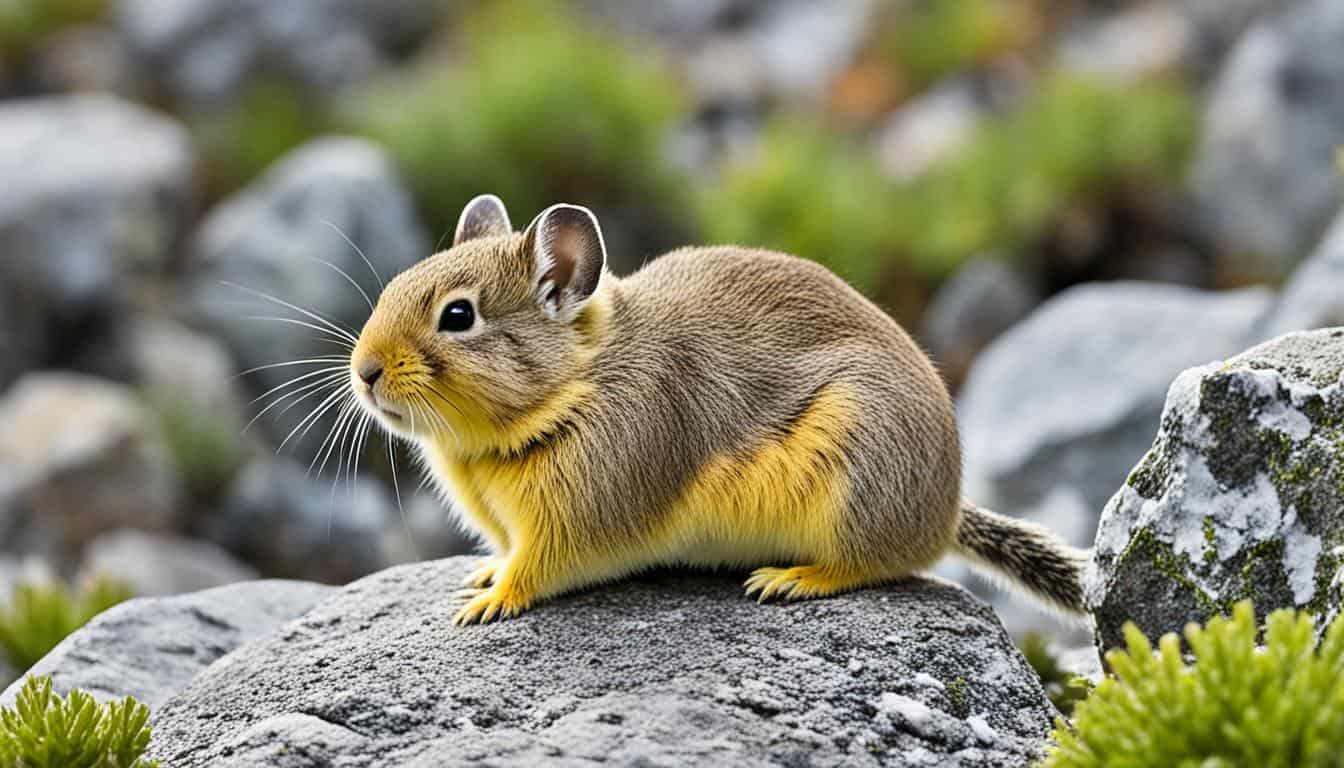Ever wondered how the American pika survives in tough, rocky areas of western North America? Its home stretches from central British Columbia and Alberta in Canada, through Oregon to New Mexico in the U.S. This animals’ habitat is not only vast but also varied.
Found mostly at or above tree line, American pikas live on talus fields with some green around. In colder, higher areas, they are less common, needing the cool weather to live. Let’s look into the interesting range of the American pika. We’ll learn how they’ve adapted to their environment.
Introduction to the American Pika
The American pika (Ochotona princeps) is a small, diurnal mammal. It’s closely related to rabbits and hares. You can usually spot these cute creatures in the boulder fields and high spots of the West’s mountains. They are known to be very sensitive to changes in temperature. This makes them key players in talks about saving the environment.
To truly understand the American pika distribution, you must know about their home. American pikas live in places where the air is cooler at high altitudes. This cool weather is critical for their life. Even though they are not considered in immediate danger (“Least Concern” status), they are threatened by home loss and global warming. These threats are especially serious in the southwest.
American pikas are interesting for a few reasons. They are active during the day and like cool places. Because of this, they can tell us a lot about the state of the environment. Their ability to live in tough conditions and the dangers they face show why we should study and protect them.
The Habitat of the American Pika
The American pika lives in high places like rocky talus fields. These fields are at the top of alpine areas and have a lot of rocky debris. These tiny mammals call these cold and rocky places home. They can be found from low lands in the north to over 2,500 meters in the south.
Location and Elevation
In the north, American pikas can live at sea level. But, as you go south, they need much higher places. They choose these high spots to stay cool, even in the summer heat. So, whether they’re near tall mountains or cold streams, they like it chilly.
Rocky Mountain Terrain
The Rocky Mountains’ rough terrain is perfect for American pikas. Crevices in talus slopes are used for hiding and food storage. These rocks keep them safe and help them survive. Despite the tough conditions, pikas have adapted well. They are truly at home in these rocky, high places.
What is the range of the American pika?
The American pika lives in mountainous areas. Their range goes from British Columbia and Alberta in Canada to the western United States. This includes places like the Sierra Nevada. It doesn’t include the Great Basin because it’s too harsh there. Pikas like rocks and cooler places. These conditions are important for their life and finding food.
A good American pika range map helps us understand where they live. It shows us how the environment affects them. Pikas need rocky places and the right climate to survive. Such maps are very useful to see their living areas and needs.
American pikas have interesting ways to find food and stay alive. They save food in piles for winter. This helps them when food is hard to find. By learning about American pika behaviors, people can protect them better. Conservationists use this knowledge to keep these animals safe.
Detailed American Pika Range Map
The American pika habitat map shows us where these small mammals live. It’s very important in understanding their territory. Pikas mostly live in the high parts of the western mountains. These places have a lot of plants that they need to survive.
Pikas stay away from lower areas. They don’t get enough protection from the cold and hot weather there. The American pika habitat map tells us a lot about what they need to live. By looking at this map, we can see where they are and where their homes should be protected.
Looking closely at the American pika territories, we see they like rocky places with plants. These places are good for finding food and staying safe. This kind of map helps us figure out how to protect their homes.
American Pika Distribution Across North America
The American pika is a small, tough creature that lives in North America’s high places. It is found in areas with certain climate and land features. These include both the United States and Canada.
Canada
In Canada, these small animals live in high places like British Columbia and Alberta. These areas are cold with lots of rocks. This type of climate and land features are perfect for pikas. They especially like places in the middle of these provinces that have cool temperatures.
United States
In the United States, the American pika lives over a large area. You can see them from Oregon to New Mexico, hitting many states in between. They love places like the Rocky Mountains and the Sierra Nevadas. But, the Great Basin is too warm and lacks the rocks they need to survive.
| Region | State or Province | Habitat Characteristics |
|---|---|---|
| Canada | British Columbia, Alberta | Cold, rocky terrains in the Canadian Rockies |
| United States | Oregon, Washington, Idaho, Montana, Wyoming, Colorado, Utah, Nevada, California, New Mexico | High-altitude regions, predominantly in the Rocky and Sierra Nevada Mountains |
American Pika Population Trends
The American pika population is staying steady in the Northwestern parts. However, its numbers are dropping in the south. This problem is big because habitats are disappearing, and global warming spreads far and wide effects. This makes it tough for pikas to find food, putting pressure on where they can live.
Keeping an eye on how the American pika population changes is very important. It helps us figure out how to save them. Places in the northwest keep a good number of pikas thanks to colder weather and good homes. But, in the south, things are hard because of heat and losing their place to live.
Here are the main reasons for the drop in pikas:
- Hotter days are happening more often because of American pika global warming.
- People and nature changes are making fewer good places for them to live.
- Changes in rain affect the food pikas can find.
Even though there are still many pikas in the north, their numbers dropping in the south is a major worry. This means we need to do more to keep them safe. Scientists are watching closely. They give us important info to help pikas fight bad effects from losing their home and global warming.
Climatic and Environmental Factors
The American pika climatic sensitivity is key for its survival. High day temperatures are a big danger. Pikas are used to cool places, so they’re at risk from hot weather.
Snow covering is vital for pikas. It keeps them warm in winter. But, as snow changes with global warming, so do the American pika environmental impact. This affects where they live and their numbers.
Now, let’s see how climate and the environment change pikas’ lives:
| Climatic Factor | Impact on American Pika |
|---|---|
| High Diurnal Temperatures | Risk of overheating, limited activity periods. |
| Snowpack Levels | Provides insulation, impacts winter survival. |
| Habitat Elevation | Determines the availability of suitable cold habitats. |
| Vegetation Cover | Affects food availability and nesting materials. |
The American pika’s future needs global warming’s effects reduced.
We must act to protect pikas from warming. Saving them means understanding their need for cool places.
Adaptations of the American Pika
The American pika shows what it means to adapt to its home high up in the mountains. They deal with big changes in weather and need snow to survive. This shows their strength and also how hard their life can be.

Temperature Sensitivity
These small creatures, the American pikas, are very sensitive to the temperature. They pick cool spots to keep from getting too hot. This keeps them in good shape, especially when it’s warm.
Snowpack Reliance
Winter survival is all about the snow for the American pika. Snow keeps them warm by trapping heat. They use this to save energy and make it through the cold winter months.
Their need for the right temperature and winter snowpack shows how unique their needs are. Their way of life is at risk from any changes in their environment.
American Pika Behavior and Seasonal Movements
The American pika shows interesting behaviors that change as seasons do. This is called American pika seasonal behavior. During summer, they are very active. They look for food a lot.
They are very careful in how they gather and save plants for winter. This method is called “haying.” It helps them survive by ensuring they have food when finding fresh plants is hard. They pick plants that are the most nutritious.
When you learn more about them, you’ll see that American pika seasonal behavior means they don’t move around a lot. They stay in their rocky homes all year. This shows how important their small, specific habitats are to them. These places not only offer safety but also a special climate.
The American pika’s way of gathering food is also impressive. They work hard to gather enough food for winter. This helps them stay healthy in the cold, snowy months.
Conservation Status and Efforts
The American pika is listed as ‘Least Concern.’ It might seem like they have it easy. But, there are big worries about their environment in certain areas. Experts point out that calling their status ‘Least Concern’ ignores how some places see big changes in their numbers.
Protection efforts aim to stop habitat loss, the main threat to pikas. Saving the places they live in helps protect their home. Also, research on how climate change affects them is crucial. This includes understanding new stressors they face.
Studying how pikas live and act helps create smart plans to save them. Knowing what temperatures they like, how they find food, and their seasonal habits is key. This info helps make plans that are right for saving pikas over time.
| Region | Key Conservation Actions |
|---|---|
| Northwestern United States | Habitat Protection, Climate Change Research |
| Southwestern United States | Climate Monitoring, Habitat Restoration |
| Canada | Ecological Studies, Conservation Policy Development |
Interesting Facts About the American Pika
Don’t be fooled by their adorable looks, American pikas have a lot of cool things going on. Their diet is quite interesting, filled with lots of green plants. They work hard to gather and dry these plants in summer. This process, called “haying,” helps them have enough food to last through winter.
The American pika’s love life is fascinating too. They can have up to two sets of babies in a year. They are very picky about their space, always looking out for danger. Each pika marks its own territory, where they find food and protect their stuff.
Let’s dive into more details about what the American pika eats and how they make families:
| Aspect | Details |
|---|---|
| American Pika Diet | Various green plants, stored as hay for winter survival. |
| American Pika Mating Habits | Potential for up to two litters per year, involving marked territorial behaviors. |
Conclusion
The American pika is an adaptable but fragile creature, showing us a special view of mountain ecosystem health. It thrives in cold, high places, highlighting its close tie with its home. Studying how it lives gives us clues to the balance in these areas.
The pika’s narrow range points to its need for very specific spots and how vital weather is to it. This makes them an important species to watch as the planet changes. They face big challenges from losing places to live and a warmer world, making saving them critical.
Protecting the American pika means more than just helping one species. By taking actions against climate change and conserving their homes, you help save a part of nature. Their presence is a sign of healthy mountain lands and a thriving ecosystem. So, looking out for the pika means protecting a whole life web up in the high places.
FAQ
What is the range of the American pika?
The American pika lives from central British Columbia and Alberta in Canada to the western U.S. This includes states like Oregon, Washington, and Montana. It continues on to Wyoming, Colorado, Utah, and even New Mexico.
What habitats do American pikas prefer?
American pikas like to live in rocky areas high up, often above where trees grow. They love cool, alpine climates.
How does the American pika adapt to its environment?
To stay warm, pikas find cool spots and use the snow for insulation in winter. They are very sensitive to changes in temperature.
What factors threaten the American pika’s survival?
The biggest threats to pikas are loss of habitat and global warming. These can reduce their numbers, especially in the southwest U.S.
How do American pikas exhibit seasonal behavior?
In summer, pikas gather and store food to eat in winter. They keep these dried plants in their homes in the rocks.
What is the conservation status of the American pika?
The American pika is labeled as ‘Least Concern’ by the IUCN due to its large population. However, it faces climate and habitat problems, especially in the south.
Where can American pikas be found in North America?
You can spot American pikas in central British Columbia and Alberta and the western U.S. This includes areas like the Sierra Nevada but not the Great Basin.
What do American pikas eat?
Pikas eat green plants and store them for winter. This behavior is called “haying.” They rely on these stored plants when they can’t find fresh food.
How do climatic and environmental factors affect American pikas?
Changes in climate, like warmer temperatures and less snow, impact pikas a lot. These changes can limit where they can live and how they find food.
What are some interesting facts about American pikas?
American pikas are interesting for their food storage and social life. They mark their territories and are always watching for predators. They can have up to two litters each year.
Why is the American pika important in environmental discussions?
The American pika is key for understanding mountain ecosystems’ health. They react strongly to climate and habitat changes, making them important for environmental talks.







